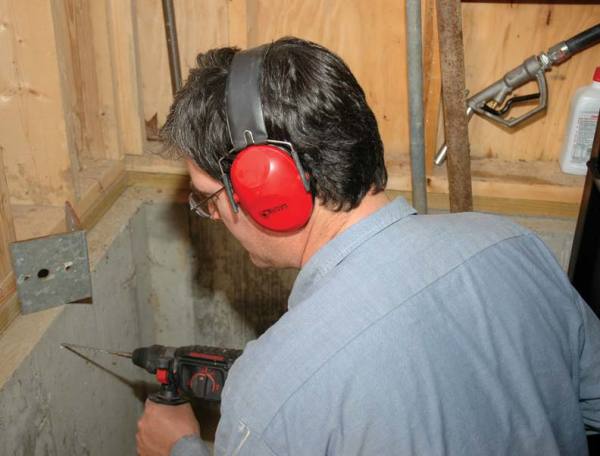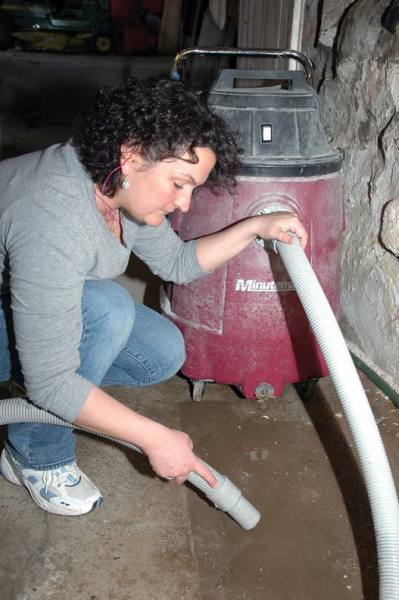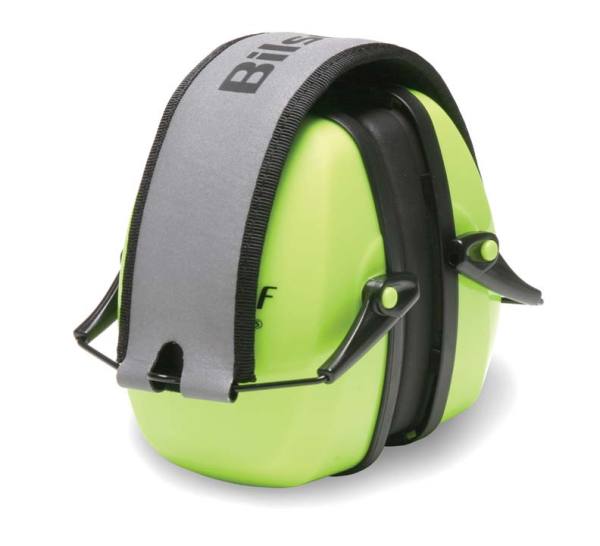The average electric drill emits more than 100 decibels of sound, enough to damage ears after just 15 minutes of unprotected exposure. (Photo: Peter Lord)
Ever notice how many contractors are loud talkers? It probably isn’t just because they want your attention. Continued exposure to equipment and tool noise can often result in hearing loss, especially for people who skimp on ear protection. Because there are many more obvious dangers on most home projects (fumes, burns, flying debris), ear protection often gets overlooked. Consequently, noise on the job site—a very serious and insidious hazard—is often an afterthought until it’s too late.
Shrieking shop vacuums, whining saws, rumbling generators, and growling compressors resonate through job sites every day. Any one of these items can easily emit more than 85 decibels of sound (and some well over 100), a level that can cause temporary hearing loss after just one hour of unprotected exposure. Exposure to excessive noise is the second leading cause of hearing loss (behind aging), and audiologists are seeing more impairment at younger ages than ever before. Many experts believe that age-related hearing loss is also directly related to the cumulative effect of noise exposure through the years, so how you take care of your ears today really does make a difference.
The simplest protection measure for ears—wearing earplugs—is often skipped because earplugs are an extra step to remember, aren’t always handy, and, well, people think they look silly. But since prolonged exposure to loud noise, even short bursts of sound at high decibels, can cause permanent hearing loss, it’s worth taking a minute to make sure your eardrums are covered.
What’s the Noise?
Before using any type of loud equipment—even a utility vacuum—make sure your ears are covered, as with the corded earplugs here. (Photo: Peter Lord)
Noise is an energy wave measured in decibel (dB) units. The decibel scale is a logarithmic scale, with one decibel equaling the log of a ratio between two sound pressures. It’s a complicated measuring system, but the important thing to know is that a very small increase in decibels is actually a quite dramatic increase in sound pressure level, or noise. Normal conversation runs around 50 dB, and experts believe that exposure to noise above 85 dB without protection can damage hearing.
Excessive noise hurts cells within the cochlea, a snail-shaped organ inside the ear. These cells are tiny hair-like projections along the auditory nerve that are stimulated by sound, and, when treated properly, they transmit sound through the auditory nerve to the brain for interpretation. When they are abused by excessive decibel levels, however, these hair-like projections become damaged or destroyed. Jonathan Klane, a Certified Occupational Hearing Conservationist, likens the damage to walking through a field of grass. The first time you trample grass, it crushes under your step, but quickly springs back to stand upright again. Walk along the same path of grass day after day, however, and over time it loses its ability to bounce back, eventually wearing away, dying, and becoming unable to regenerate. Likewise, the delicate cells of the cochlea can repair damage in the short term, but if the trauma continues, damage becomes permanent.
Noise can cause hearing loss based on its intensity (decibel level), duration (length of exposure), and proximity. The farther you get from a noise source, the more you decrease its potential for damage. Called the Inverse Square Law, this means that a high-decibel noise heard at twice the distance from its source (30 feet instead of 15, for example) has one-quarter the damaging impact. Don’t assume you’re safe, however, just because your shop vacuum has a long hose; anytime blowers or fans are involved, noise is intensified. While distance can be helpful, when ears are unprotected, you’d have to enclose the noise 100 percent to significantly reduce the hazard.
Earmuff-type protection is one of many ways to stave off hearing damage.
It’s important to remember, too, that we perceive things differently than our bodies. We are much more tolerant of being around enjoyable noises (like a rock concert) or something we’ve become accustomed to (like a tool we use frequently). Our ears don’t make a distinction, however. Anything loud threatens their vulnerable protective system.
Hearing isn’t the only thing that can suffer from excessive noise. Chronic noise exposure also raises stress levels, elevates blood pressure, and can cause ringing, whining, or ocean-wave sounds in your head that disrupt work, concentration, and sleep.
Reduce the Risk
You can take measures to lower the hazard noise presents. When replacing tools or equipment, research the sound output of the engine, motor, or fans—most manufacturers can tell you a machine’s decibel level. You can purchase sound-deadening add-ons for some motors, sort of like a muffler. Often, simply relocating the source of noise by moving the generator or compressor around the corner can significantly reduce exposure. You should also close off work areas to reduce exposure to other workers, your family, and even pets.
Many tools—saws, vacuums, even hammers—are loud enough to require hearing protection. Earmuff-style ear covers may not look cool, and they’re one more thing to remember when suiting up, but they’re best for blocking out decibels, and are pretty easy to wear properly. Earplugs, which are much less obvious in appearance, come in foam, plastic, and custom-molded varieties, but can be challenging to place in the ear canal correctly. Getting a proper fit involves pulling the top of the ear up and back in order to straighten and open the ear canal, and it’s essential—otherwise, the earplugs will drift out of the ear canal with movement and over time. Foam earplugs often don’t stay in place, so consider firmer plastic plugs, with oval-shaped ends harboring three or four rings or ridges to allow for a better fit and grip. Remember, you only have one pair of ears, so it’s worth taking the time to protect them.







